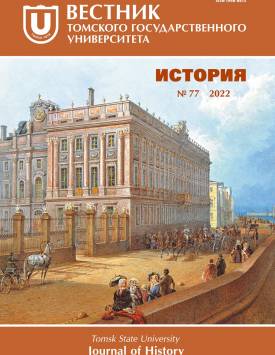Old Believer communities of Buryatia in the conditions of Economic and socio-cultural modernization of the 1920s: adaptation and confrontation
The topicality of the research is due to the necessity of analyses of group and individual strategies of adaptation, coexistence and resistance of the traditional communities, including the Old Believers’ communities, under the new social reality of 1920s. This period is characterized with fast shift from one economic condition to other, transformation of political, economic and social spheres, and the break of traditional ideas. The research will be enable to significantly adjust the contemporary vision of economic and socio-cultural modernization of national autonomy - the Buryat-Mongolian ASSR. The article focuses on the features of interiorization of the Soviet power by the Old Believers with the accent on the problem of adaptation of novelties into everyday life. Based on the published resources and archive materials the article reveals the specificity of the relationships between the Old Believers’ communities and authorities. It also shows the reactions of the Old Believers on methods of antireligious agitation and propaganda; provides the analysis of their attitude to modernization projects in education and health care; examines the features of assimilating the novelties in economic, leisure and everyday practices, in marriage and family relations. The complicated process of assimilating new social practices and economic relations imposed by the Soviet power in the Buryat-Mongolian ASSR developed gradually because of the late establishment of the Soviet power and ethnocultural and economic features of the region. Firstly, the Old Believers took new power as a force that could adjust local life, but with the growth of antireligious struggle their attitude to atheistic power turned into negative. The authorities started to use administrative levers to influence the Old Believers’ communities, and methods of socio-cultural events relating to every sphere of people’s life became more and more aggressive, which increased the Old Believers’ aversion of the atheistic regime and facilitated the popularity of opposition attitudes. The research shows that the more conservative a community is, the harder its members, especially the most orthodox ones, perceive novelties, the stronger they oppose and resist these novelties. The practice of implementing the Soviet modernization projects of the 1920s revealed that the state must take into account the historical, ethnocultural and confessional features of the regions and the peoples inhabiting them when choosing the means and elaborating the mechanisms of reforming the society. The authors declare no conflicts of interests.
Keywords
the Old Believers of Buryatia, Soviet power, modernization, adaptation, resistanceAuthors
| Name | Organization | |
| Plekhanova Anna M. | Institute for Mongolian, Buddhist and Tibetan Studies of the Siberian Branch of the Russian Academy of Sciences | plehanova.am@mail.ru |
| Tsyrempilova Irina S. | East Siberian State Institute of Culture | irina161073@mail.ru |
References

Old Believer communities of Buryatia in the conditions of Economic and socio-cultural modernization of the 1920s: adaptation and confrontation | Tomsk State University Journal of History. 2022. № 77. DOI: 10.17223/19988613/77/5
